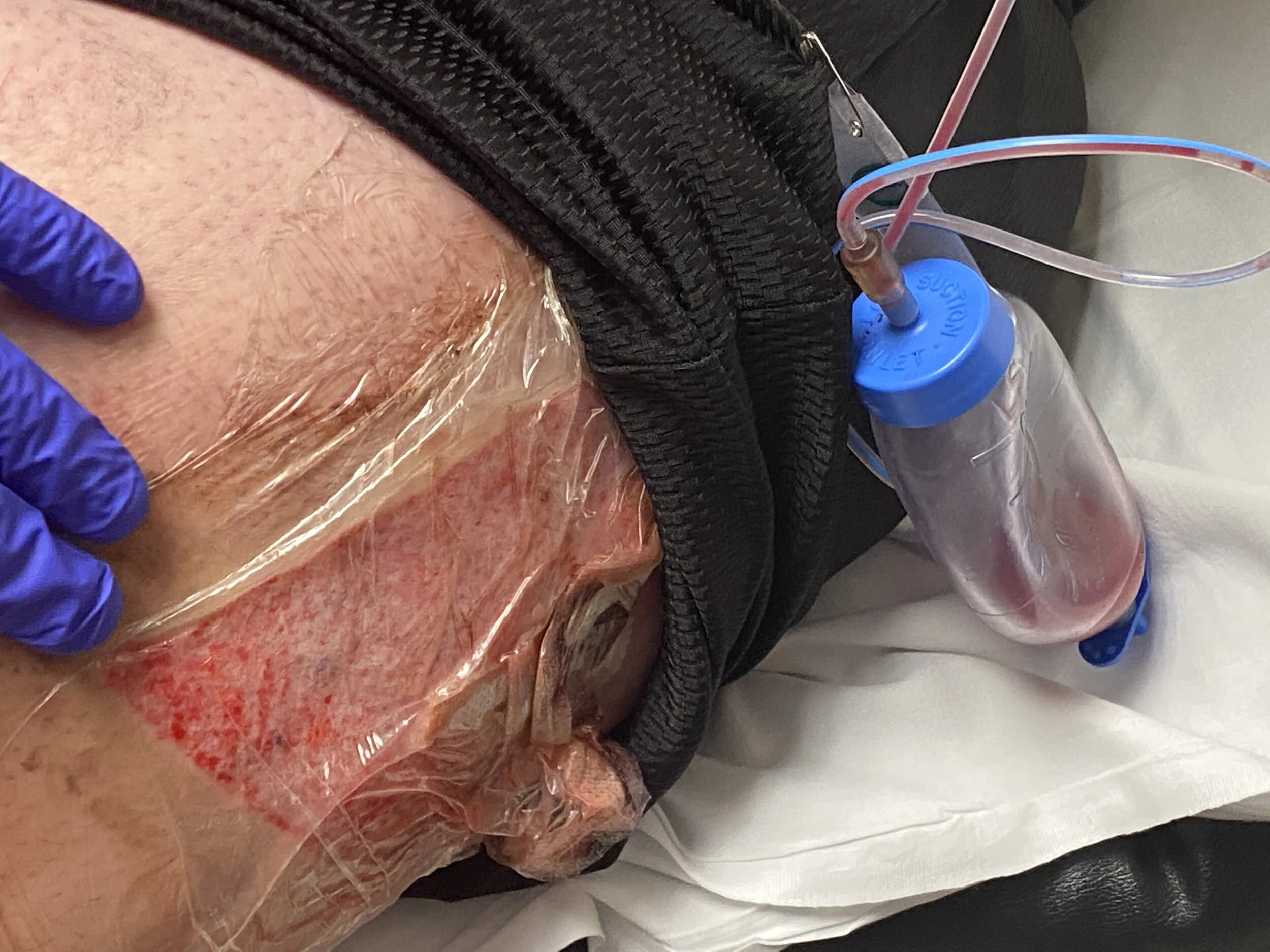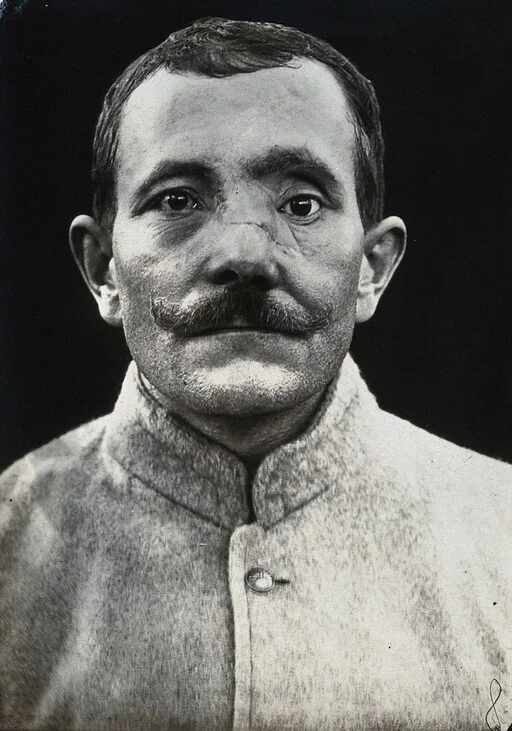Practice Pearls for Plastic Surgery Patients in the Emergency Department: Autografts.
Part I in a Series
The skin is the largest organ in the body and should be treated with extreme care. A skin graft is typically used for patients who suffer from burns, chronic wounds, trauma, cancer or other injuries. These patients may develop infection, swelling, and pain, presenting post-operatively to the emergency department. We will discuss the most common complaints related to skin grafts and present a detailed patient case. We also will show you a common skin graft with drain placement, while also discussing what is “normal” and what is “abnormal”.
Skin grafts are extremely complicated procedures that have two major areas of concern. First, the skin graft site is sensitive and tender post harvesting. The area may or may not have been treated with numbing agents such as lidocaine and these local anesthetics will have worn off. The site can appear red, raw and even be pruritic. The patient may need a dressing change over this area. You may consider using a large tegraderm to cover the harvest site. The area where the graft is applied is also sensitive and extremely delicate. Both sites are at risk for pain, infection and failure. There are many factors involved in healing including thickness, location, blood supply, underlying comorbidities, history of infection or complications and whether or not biosynthetic materials have been used.
Above Photos: The upper left thigh, post autograft harvest, with drain. These photos depict well harvest healing sites and expected stage of healing. Photos by: M. Roberts NP


Above images: Real patients, real stories, the real educators. We salute you.
Young obese female patient status post chronic wound after complex motorvehicle accident. Her graft is a partial or splint thickness autograft (from her left upper thigh) with grafting mesh. Photo by: M. Roberts NP
This case involves a patient autograft. Autografts can be full thickness or partial (split) thickness. A full-thickness graft will include all the layers of the skin (epidermis, dermis and subcutaneous fat). Keep in mind, patients with a partial/split-thickness graft have a graft that is only composed of the epidermis and a variable amount of dermis. These grafts are great for large areas of coverage, but are more fragile than full thickness grafts. Split or partial grafts will also vascularize quicker than full thickness grafts as the thicker grafts drain poorly and have greater depth. The overall survivability of a skin graft depends entirely on the blood supply of the recipient wound bed. The first 48-72 hours is crucial to recovery (UpToDate, 2020, Leon-Viallapalos et al).
The patient status post partial or split thickness autograft (from herself) that had graft meshing completed, which was then applied to the left upper extremity. Some skin grafts may undergo graft meshing. This technique occurs after the skin graft is harvested from the donor site. The skin is placed into a special machine (that can look like a mini pasta maker) that makes slits that allows for expansion. The healing will occur between the mesh fill and new skin will growth around it. This is when graft meshing can be used to expand the surface area of the graft skin and help with drainage and healing as well as improve outcomes (Henderson et al., 2012). The mesh looks a lot like the mesh you may find around a lamb roast or a fishing net. If you are a vegetarian, it may look a lot like a plastic strawberry basket.
This patient was having post-operative pain, swelling and splint complications. She had traveled to another ED in the area and treatment was completed. The treatments done were inappropriate and compromised her skin graft. Luckily, when she arrived in our ED, we were able to fix her underlying issues and put her on the road to recovery. This part of our blog will introduce grafts and presentation, while our future series will include splinting techniques and follow up treatments.
Time to Proceed
The Approach
Careful examination, consultation, and review of an autograft with preparation for splinting and tips from our plastic surgery experts
The Pause
Did you call the surgeon who did this procedure, immediately? Time is precious.
The Procedure
- The first part of preparing for skin graft treatment is to know what you are dealing with and the date of the surgery. Be sure to get as many details about the graft as possible.
- Pre treat the patient with IV or oral pain control before exposing the site. In this case, we offered oral Acetaminophen 1000 mg combined with Oxycodone rapid release tablets 10 mg. The patient still had pain and later received IV analgesics post exposure and treatment with new splint.
- Keep the patient in a private area to avoid exposing the site to contaminants.
- Remove all dressings that are circumferential, binding, tight or constrictive in any way.
- Look closely at the sutures around the site. If the sutures are intact and the graft appears to have a pink and red hue, the site is perfusing well.
- You can then re-bandage the site and/or splint the site. We will show you how to do this in our next blog.
Limitations: To transfer, or not to transfer that is the question
The ability to send images to experts in rural communities has been both helpful to providers and to patients. More times than not, patients need to drive an hour or more to specialty care and can show up in your urgent care or tertiary care center. We have both worked in rural care communities and have had issues about whether to transfer the patient or not for urgent or complex issues. Our suggestion is to talk to the surgeon who completed the surgery and obtain details. If the patient does not know their history (which is common), you can ask the following questions:
1. When did you complete the surgery?
2. Was this a skin graft, skin substitute or tissue flap with or without grafting?
3. Is the patient on antibiotics (or given any in the last 72 hours)?
4. Is this the patient’s first graft?
5. What is the plan for pain control?
Be prepared to give the surgeon details of what you see and vital signs.
Check out the real case on video and how to proceed by watching below.
Skin graft making machines are fascinating devices
Check out our expert opinions on graft care procedures below.
Time to Process
A word on Antibiotics, Creams, and Skin Grafts
It has been documented in the literature surgeons will give their patients prophylaxis antibiotics (Moorhead, Torres, 2009). There is no consensus on the use of oral antibiotic prophylaxis for graft patients. Patients with total body surface area (TBSA) > 35%, age > 55 years and diabetic patients may have an increased risk of complications and infection (Thourani, et. al., 2013). The standard of care by most plastic surgeons is to provide prophylaxis antibiotics at this time to the majority of patients. Surgeons also suggest wound care should begin immediately, which is the key to healing. Patients may shower on the second day after the procedure and apply a generous amount of antibiotic ointment (which should be applied BEFORE the shower). Although topical scar treatments (silicon, Mederma etc.) may help, they are not used until later in the recovery process, usually around 6 weeks time (Weathers et. al., 2013).
A Bit of History
The use of skin grafting dates back to 2500 years ago. One of the first cases was documented in India and the early 1900’s. It has been used to help with reconstruction for hundreds of years (Weathers et. al. 2013).
Cranio-facial injury: a French soldier with a skin graft to the bridge of the nose, following plastic surgery. Photograph, 1916.
Photo courtesy of Creative Commons.
Expert Opinions
Martha Roberts, NP weighs in
- Skin grafts of any kind may appear scary and confusing. Don’t let their shape or appearance scare you. Get a good look at the graft and the autograft site (if there is one). Vital signs and color of the graft will give you more information.
- Never, ever, put a tight or (even snug) circumferential splint dressing on a graft.
- If this column has piqued your interest, be sure to follow the next few columns.
Dr. James Roberts, MD weighs in
- The surgeon must be contacted if the patient is in your ED or urgent care. Give the details of the case to them and you can send them a secure photo.
- Not all patients will be on pre-operative antibiotics. Discuss whether or not antibiotics patient should be prescribed. If patient appears septic or with severe infection, consider starting broad-spectrum antibiotics such as Zosyn +/- Vancomycin. These patients are admitted.
Dr. Corey Bascone, MD, MBA
Plastic Surgeon, UC Davis weighs in
- So my somewhat more innovative way to care for harvest site is 5 days with mepilex AG on the harvest site. Then change the mepilex AG on POD5 for an additional 5 days vs xeroform for an additional 5 (if mepilex AG unavailable outside of the OR/limited stock). Either way on POD #10- I recommend only Eucerin lotion application BID unless there’s some area of the harvest site with delayed healing. Then I will continue to place a small amount of xeroform on that location. Lotion everywhere else.
References
Henderson, R., Arya, R., Gillespie, P. Skin graft meshing, over-meshing and cross-meshing. International Journal of Surgery, 10(9); 2012, pages 547-550. https://doi.org/10.1016/j.ijsu.2012.08.013
Leon-Villapalos, J., Butler, C., Jeschke, M., Collins, Kathryn. Skin Autografting. Up To Date. 2020. Retreived from https://www.uptodate.com/contents/skin-autografting?search=skin%20graft&source=search_result&selectedTitle=1~150&usage_type=default&display_rank=1 on October 25, 2020.
Moorehead, C., Torres, A., Prevent bacterial resistance: an update on the use of antibiotics in dermatologic surgery. Dermatologic Surgery, 10, 2019; pages 1532-1538.
Weathers, W., Bhadkamkar, M., Wolfwinkel, B, Thornton, J. Full-thickness skin grafting in nasal reconstruction. Seminars in Plastic Surgery, 2013 May; 27(2): 90–95. doi: 10.1055/s-0033-1351227
Thourani, V., Ingram, W., Feliciano, D. Factors affecting success of split-thickness skin grafts in the modern burn unit. The Journal of Trauma: Injury, Infection, and Critical Care: March 2003 - Volume 54 - Issue 3 - p 562-568 doi: 10.1097/01.TA.0000053246.04307.2E
Image credit: French Solider
https://search.creativecommons.org/photos/a3b97113-bc00-4ae8-838b-7b60b9dd639c



